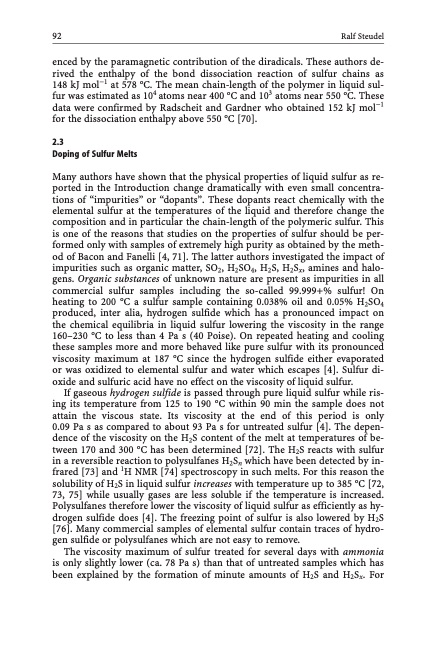
PDF Publication Title:
Text from PDF Page: 102
92 Ralf Steudel enced by the paramagnetic contribution of the diradicals. These authors de- rived the enthalpy of the bond dissociation reaction of sulfur chains as 148 kJ mol1 at 578 C. The mean chain-length of the polymer in liquid sul- fur was estimated as 104 atoms near 400 C and 103 atoms near 550 C. These data were confirmed by Radscheit and Gardner who obtained 152 kJ mol1 for the dissociation enthalpy above 550 C [70]. 2.3 Doping of Sulfur Melts Many authors have shown that the physical properties of liquid sulfur as re- ported in the Introduction change dramatically with even small concentra- tions of “impurities” or “dopants”. These dopants react chemically with the elemental sulfur at the temperatures of the liquid and therefore change the composition and in particular the chain-length of the polymeric sulfur. This is one of the reasons that studies on the properties of sulfur should be per- formed only with samples of extremely high purity as obtained by the meth- od of Bacon and Fanelli [4, 71]. The latter authors investigated the impact of impurities such as organic matter, SO2, H2SO4, H2S, H2Sx, amines and halo- gens. Organic substances of unknown nature are present as impurities in all commercial sulfur samples including the so-called 99.999+% sulfur! On heating to 200 C a sulfur sample containing 0.038% oil and 0.05% H2SO4 produced, inter alia, hydrogen sulfide which has a pronounced impact on the chemical equilibria in liquid sulfur lowering the viscosity in the range 160–230 C to less than 4 Pa s (40 Poise). On repeated heating and cooling these samples more and more behaved like pure sulfur with its pronounced viscosity maximum at 187 C since the hydrogen sulfide either evaporated or was oxidized to elemental sulfur and water which escapes [4]. Sulfur di- oxide and sulfuric acid have no effect on the viscosity of liquid sulfur. If gaseous hydrogen sulfide is passed through pure liquid sulfur while ris- ing its temperature from 125 to 190 C within 90 min the sample does not attain the viscous state. Its viscosity at the end of this period is only 0.09 Pa s as compared to about 93 Pa s for untreated sulfur [4]. The depen- dence of the viscosity on the H2S content of the melt at temperatures of be- tween 170 and 300 C has been determined [72]. The H2S reacts with sulfur in a reversible reaction to polysulfanes H2Sn which have been detected by in- frared [73] and 1H NMR [74] spectroscopy in such melts. For this reason the solubility of H2S in liquid sulfur increases with temperature up to 385 C [72, 73, 75] while usually gases are less soluble if the temperature is increased. Polysulfanes therefore lower the viscosity of liquid sulfur as efficiently as hy- drogen sulfide does [4]. The freezing point of sulfur is also lowered by H2S [76]. Many commercial samples of elemental sulfur contain traces of hydro- gen sulfide or polysulfanes which are not easy to remove. The viscosity maximum of sulfur treated for several days with ammonia is only slightly lower (ca. 78 Pa s) than that of untreated samples which has been explained by the formation of minute amounts of H2S and H2Sx. ForPDF Image | Topics in Current Chemistry

PDF Search Title:
Topics in Current ChemistryOriginal File Name Searched:
Elemental-Sulfur-und-Sulfur-Rich-Compounds-I.pdfDIY PDF Search: Google It | Yahoo | Bing
Sulfur Deposition on Carbon Nanofibers using Supercritical CO2 Sulfur Deposition on Carbon Nanofibers using Supercritical CO2. Gamma sulfur also known as mother of pearl sulfur and nacreous sulfur... More Info
CO2 Organic Rankine Cycle Experimenter Platform The supercritical CO2 phase change system is both a heat pump and organic rankine cycle which can be used for those purposes and as a supercritical extractor for advanced subcritical and supercritical extraction technology. Uses include producing nanoparticles, precious metal CO2 extraction, lithium battery recycling, and other applications... More Info
| CONTACT TEL: 608-238-6001 Email: greg@infinityturbine.com | RSS | AMP |